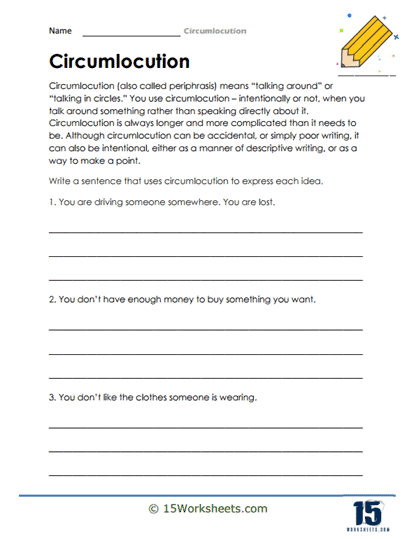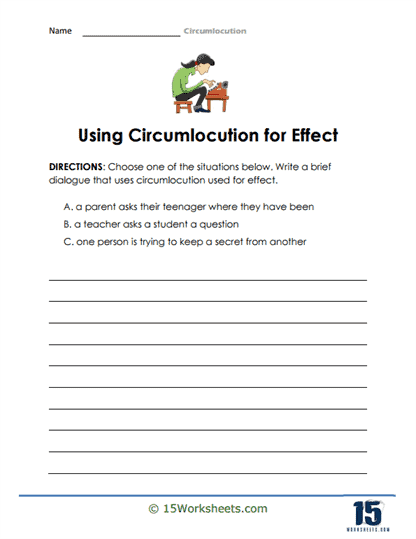Circumlocution Worksheets
About These 15 Worksheets
Circumlocution, a verbal strategy of describing or defining a concept, object, or term without naming it directly, serves as a pivotal skill in both language learning and literary analysis. These worksheets were created to cultivate this skill, offering a range of exercises that challenge students to navigate language more flexibly and creatively. These worksheets not only enhance vocabulary and expression but also deepen students’ understanding of context, nuance, and the multifaceted nature of language. Through various types of exercises, students learn to convey ideas by circumventing direct expressions, which enriches their language arts and reading skills significantly.
Understanding Circumlocution
At its core, circumlocution is about verbal dexterity. It requires the speaker or writer to convey meaning through alternative descriptions, explanations, or synonyms, especially when the exact term is unknown, forgotten, or deliberately avoided. This skill is invaluable for language learners and native speakers alike, offering a way to communicate effectively despite gaps in vocabulary or knowledge.
Through a variety of exercises, these worksheets encourage students to expand their vocabulary, think creatively, and communicate effectively, even in the absence of specific terms.
The skills developed through circumlocution practice-ranging from creative expression to problem-solving and adaptability in communication-are not only crucial for academic success but also for navigating the complexities of everyday language use. By integrating circumlocution worksheets into the curriculum, educators can provide students with a fun, challenging, and effective way to deepen their understanding of language and its possibilities, preparing them for a lifetime of skilled and adaptable communication.
Types of Exercises
Circumlocution worksheets comprise several exercise types, each targeting different aspects of this linguistic strategy:
Definition Without Naming – Students are given definitions, descriptions, or series of clues leading to a specific word or phrase, but they must avoid using the word itself. This exercise improves vocabulary and encourages students to think about how words are related to their definitions and uses.
Synonym Substitution – In these exercises, learners must replace a given word in a sentence or paragraph with a synonym or a phrase that conveys the same meaning without using the original word. This not only expands vocabulary but also enhances understanding of nuance and connotation.
Guessing Games – Modeled after games like Taboo or Charades, these exercises involve describing a word or concept without using a predetermined list of words. This encourages creative thinking and quick reasoning, as students must find alternative ways to express their thoughts.
Storytelling with Constraints – Students create short narratives or descriptions while adhering to specific limitations, such as not using a particular category of words (e.g., no color words). This fosters creativity and adaptability in language use.
Paraphrasing Practice – Exercises that require students to paraphrase sentences or passages without using key terms from the original text challenge them to find new ways to express the same ideas, enhancing comprehension and retention.
Role-Playing Scenarios – Students engage in role-playing activities where they must explain concepts, objects, or situations without naming them directly, simulating real-life communication scenarios and improving conversational skills.
Improving Skills
Practicing with circumlocution worksheets offers multifaceted benefits to students, particularly in the realms of language arts and reading skills:
Vocabulary Expansion – Regular practice with circumlocution exercises naturally expands students’ vocabulary, as they must find and use alternative words and phrases to express a given concept. Circumlocution encourages creative thinking and expression. Students learn to play with language, exploring new ways to describe and discuss ideas, which can make their writing more engaging and vivid.
Enhanced Comprehension – By engaging in exercises that require understanding and conveying meanings without direct terms, students improve their reading comprehension. They become adept at inferring meaning from context, a skill critical for reading fluency and literary analysis.
Adaptability in Communication – Circumlocution worksheets prepare students for real-world communication challenges, where direct expressions may not always be possible or appropriate. They learn to navigate language barriers, avoid cultural sensitivities, and express themselves more flexibly.
Problem-Solving Skills – Finding ways to explain or define something without using the most obvious words is a complex problem-solving task. These exercises sharpen students’ cognitive abilities, enhancing their capacity to think critically and strategically about language.
Increased Language Awareness – Working with circumlocution exercises heightens students’ awareness of language structures, uses, and variations. They become more mindful of how language functions, which is fundamental for both language learning and literary study.
Improved Listening Skills – Many circumlocution exercises involve collaborative elements, requiring students to listen carefully to others’ descriptions and guesses. This fosters better listening skills, crucial for effective communication and understanding.
What is the Literary Device of Circumlocution?
Circumlocution, a nuanced literary device, involves the indirect expression of ideas or concepts by using a roundabout manner of speech instead of direct and concise language. This technique, characterized by its verbose nature, serves various purposes in literature, ranging from creating suspense to elaborating on thematic elements without explicit declaration.
Circumlocution’s main defining feature is its deliberate avoidance of straightforwardness, opting instead for a more elaborate, often convoluted, method of description or narration. This strategy can enrich a text, offering depth and complexity that direct language might not convey as effectively.
Main Defining Feature of Circumlocution
The essence of circumlocution lies in its indirectness. Unlike direct speech that aims to convey information succinctly, circumlocution meanders, using more words than necessary to describe something. This approach is not about obfuscation but rather about enriching the narrative with additional context, nuances, and layers of meaning that direct language might overlook.
Characteristics of Circumlocution
Verbose Descriptions – Circumlocution is marked by lengthy descriptions and explanations, often incorporating details that, while not strictly necessary for understanding, add depth to the narrative.
Indirect Reference – It involves speaking about subjects without naming them directly, using descriptions or allusions instead.
Use of Metaphors and Similes – Authors frequently employ metaphors, similes, and other figurative language as part of circumlocution to describe concepts in a roundabout way.
Enhancement of Mood and Atmosphere – The detailed, indirect descriptions characteristic of circumlocution can contribute significantly to the mood and atmosphere of a text, setting the tone without explicit statements.
Creation of Suspense or Mystery – By avoiding direct mention, circumlocution can create a sense of suspense or mystery, keeping readers engaged as they try to decipher the underlying meaning or anticipate what is being subtly suggested.
Examples of Circumlocution in Literature
By examining examples from Dickens, Shakespeare, and Austen, we see how circumlocution can convey thematic elements, enhance mood and atmosphere, and invite critical engagement and reflection. For readers, circumlocution transforms the reading experience, demanding active participation and offering a richer, more layered understanding of the text. Through circumlocution, authors can subtly influence readers’ perceptions and emotions, demonstrating the power of language to convey meaning in diverse and intricate ways.
Example 1 – Charles Dickens’ “A Tale of Two Cities”
“It was the best of times, it was the worst of times, it was the age of wisdom, it was the age of foolishness…”
Dickens masterfully uses circumlocution in the famous opening lines of “A Tale of Two Cities.” Rather than stating outright the conditions of the era, he describes the period through a series of paradoxical statements. This indirect approach deepens the reader’s engagement, prompting reflection on the complexities and contradictions of the time. Dickens’ use of circumlocution sets the stage for the novel’s exploration of duality and revolution, encouraging readers to consider the nuanced nature of human experience and history.
Example 2 – William Shakespeare’s “Hamlet”
“…to die, to sleep—
To sleep, perchance to dream. Ay, there’s the rub,
For in that sleep of death what dreams may come…”
In Hamlet’s soliloquy, Shakespeare employs circumlocution to delve into the protagonist’s contemplation of death and the unknown. Rather than directly stating Hamlet’s fear of death, Shakespeare explores it through the metaphor of sleep and the uncertainties that accompany it. This roundabout discussion on the nature of death and what follows reflects Hamlet’s inner turmoil and fear of the afterlife, enhancing the play’s thematic depth and emotional resonance.
Example 3 – Jane Austen’s “Pride and Prejudice”
“It is a truth universally acknowledged, that a single man in possession of a good fortune, must be in want of a wife.”
Austen uses circumlocution to satirically address societal expectations regarding marriage and wealth in the opening line of “Pride and Prejudice.” Rather than bluntly criticizing societal norms, she subtly conveys her critique through the ironic presentation of a “universal truth.” This indirect commentary invites readers to question and reflect on the social conventions of the time, demonstrating circumlocution’s power to address issues without explicit confrontation.
Effect of Circumlocution on the Reader
Circumlocution significantly impacts the reader’s experience, influencing both comprehension and engagement with the text.
Enhanced Engagement – The indirectness of circumlocution invites readers to actively participate in the narrative by piecing together the underlying meanings behind the verbose descriptions. This active engagement deepens the reader’s connection to the text.
Increased Depth of Understanding – Through its roundabout explanations and descriptions, circumlocution allows readers to explore themes, characters, and settings more thoroughly, offering insights that direct language might fail to capture.
Mood and Tone – The use of circumlocution can significantly contribute to the mood and tone of a work, guiding readers’ emotional responses and setting the atmosphere without direct statements.
Reflection and Interpretation – Circumlocution encourages reflection and interpretation, challenging readers to look beyond the surface and consider the broader implications of the narrative or dialogue.















